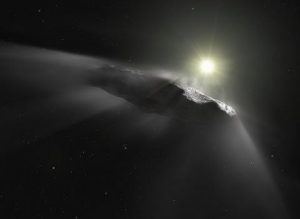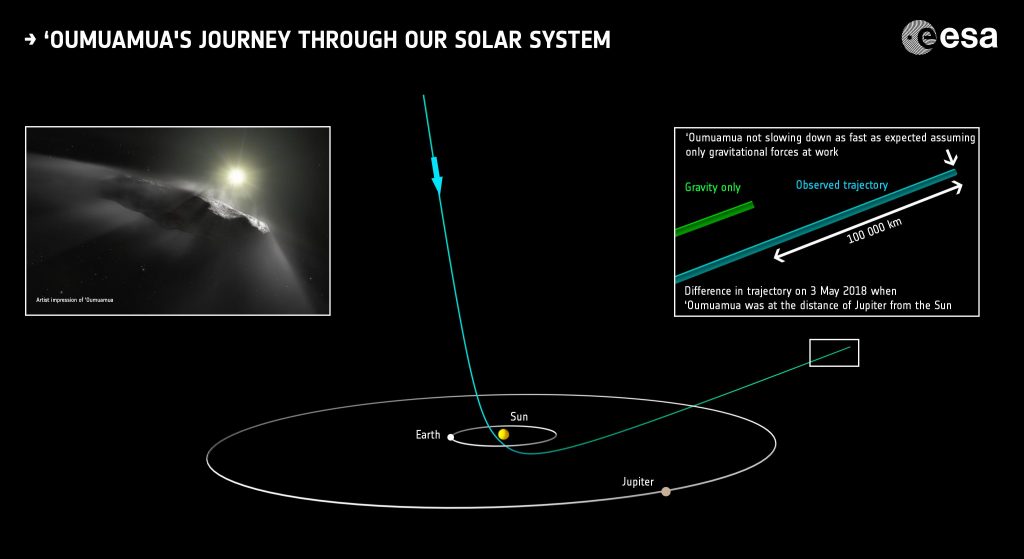New Evidence Suggests ʻOumuamua Could be a Comet
The interstellar object ʻOumuamua was discovered back on October 19, 2017, but the puzzle of its true nature is still being pieced together by scientists. Now, new evidence is surfacing to shed light on the mystery of ʻOumuamua, the first interstellar object ever seen in our solar system.
ʻOumuamua—which translates to ʻscout from the distant past’ in Hawaiian—was first discovered on Oct. 19, 2017 by astronomers at the University of Hawaiʻi’s Pan-STARRS1 telescope on Haleakalā. Scientists around the world eagerly turned their sights to the oblong-shaped mystery rock. Was it a comet? Or an asteroid? No one was sure.
Initially, astronomers assumed ʻOumuamua was a comet, but it lacked any evidence of the characteristic gas emissions and dust. Also, its trajectory—determined from data gathered by Canada-France-Hawaiʻi Telescope (CFHT) on Maunakea and other telescopes around the world—made it unlike any asteroid or comet seen before. With these observations, astronomers called it the first interstellar asteroid. However, new evidence suggests that ʻOumuamua’s may be better classified as a comet.
A team led by Marco Micheli of the European Space Agency’s (ESA) SSA-NEO Coordination Centre, and Karen Meech of the University of Hawaiʻi Institute for Astronomy has continued studying ʻOumuamua, finding that the object is shifting course from its predicted trajectory.
“Unexpectedly, we found that ʻOumuamua was not slowing down as much as it should have due to just gravitational forces,” said Micheli, lead author of the study.
In general, comets contain ices that transform from solid to gas when warmed by the Sun. Thus a fuzzy cloud appears around the comet’s surface and sometimes, a tail. Gas pressure releasing at different locations and times can change a comet’s trajectory aside from gravitational forces. This may account for the altered trajectory the team is seeing.
“Thanks to the high quality of the observations we were able to characterize the direction and magnitude of the non-gravitational perturbation, which behaves the same way as comet outgassing,” said Davide Farnocchia of NASA’s Jet Propulsion Laboratory.
Even so, no one has observed any dusty material or chemical signatures that would typically characterize a comet.
“ʻOumuamua is small—no more than a half a mile long—and it could have been releasing a small amount of relatively large dust for it to have escaped detection,” said Meech. “To really understand ʻOumuamua we would need to send a space probe to it. This is actually possible, but it would be very expensive and take a long time to get there, so it isn’t practical this time. We just have to be ready for the next one.”
“It was extremely surprising that ʻOumuamua first appeared as an asteroid, given that we expect interstellar comets should be far more abundant, so we have at least solved that particular puzzle,” said Olivier Hainaut of the European Southern Observatory. “It is still a tiny and weird object that is not behaving like a typical comet, but our results certainly lean towards it being a comet and not an asteroid after all.”
Because it is relatively small and reflects little light, current observations of ʻOumuamua can’t provide all the answers. Scientists may have to wait for the next interstellar objective to cruise through our solar neighborhood to learn more.
“When ʻOumuamua was discovered, the astronomy community gathered as much data as possible, but ultimately, the object was just not visible long enough to answer all our questions,” says Ken Chambers from Pan-STARRS. “With Pan-STARRS monitoring the skies, we hope to discover more ʻOumuamua-like objects in the future and begin to answer the really interesting questions about this class of objects.”










